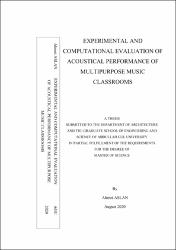| dc.contributor.author | ASLAN, Ahmet | |
| dc.date.accessioned | 2021-12-18T09:00:00Z | |
| dc.date.available | 2021-12-18T09:00:00Z | |
| dc.date.issued | 2020 | en_US |
| dc.date.submitted | 2020-08 | |
| dc.identifier.uri | https://hdl.handle.net/20.500.12573/1091 | |
| dc.description.abstract | The efficiency of education in schools is directly related to the quality of
communication in classrooms. One of the crucial factors that determines the educational
quality in schools is the acoustical performance of the classrooms. Considering the
significance of communication in educational spaces, music education is one of the
most auditory-related field of education due to its dependence on the ability to hear. The
acoustic properties and performance of spaces designated to serve as music classrooms
should be specific to the functions of music education. Using the music classroom as a
multifunctional space for the teaching of music theory and practicing musical
instruments is an application that is frequently practiced in schools. However, the
requirements for lectures and practice differ in terms of room acoustics. Therefore,
providing function-specific acoustic performance characteristics in multipurpose music
classrooms is important for the quality of education.
This study investigates the acoustical performance of three multipurpose music
classrooms of different schools by experimental and computational methods. The
schools are located on the campus of an educational institute in Kayseri. Prior to the
experimental and computational studies, the dimensions and spatial organization of
classrooms and the properties of building elements and materials are defined in detail.
At the experimental stage of the study, measurements are performed to evaluate the
background noise levels of the classrooms by comparing the results with NC (noise
criterion) curves. Impulse response measurements are conducted in the rooms in orderto derive certain acoustic parameters related to the acoustical performance of
multipurpose music classrooms. In the computational studies, three-dimensional models
of the classrooms are generated and these models are simulated through Odeon room
acoustics software. The compatibility of the acoustical simulations is inspected by
comparing the simulation results with the measurement results of room acoustic
parameters and the simulation models are calibrated. The data obtained from the studies
are analyzed and the acoustical performance of the classrooms are evaluated by
comparing the results with reference parameter values for educational institutions
defined in the regulations and literature. In order to assess the acoustical problems in
multipurpose music classrooms, an identification procedure is developed. The root
causes of the acoustical problems are locally diagnosed in the classrooms. According to
the findings acquired from the identification studies, solution proposals are discussed to
improve the acoustical performances of the classrooms. | en_US |
| dc.language.iso | eng | en_US |
| dc.publisher | Abdullah Gül Üniversitesi, Fen Bilimleri Enstitüsü | en_US |
| dc.rights | info:eu-repo/semantics/openAccess | en_US |
| dc.subject | Room Acoustics | en_US |
| dc.subject | Multipurpose Music Classrooms | en_US |
| dc.subject | Acoustical Parameters, | en_US |
| dc.subject | Acoustical Simulation | en_US |
| dc.title | EXPERIMENTAL AND COMPUTATIONAL EVALUATION OF ACOUSTICAL PERFORMANCE OF MULTIPURPOSE MUSIC CLASSROOMS | en_US |
| dc.type | masterThesis | en_US |
| dc.contributor.department | AGÜ, Fen Bilimleri Enstitüsü, Mimarlık Ana Bilim Dalı | en_US |
| dc.relation.publicationcategory | Tez | en_US |


















